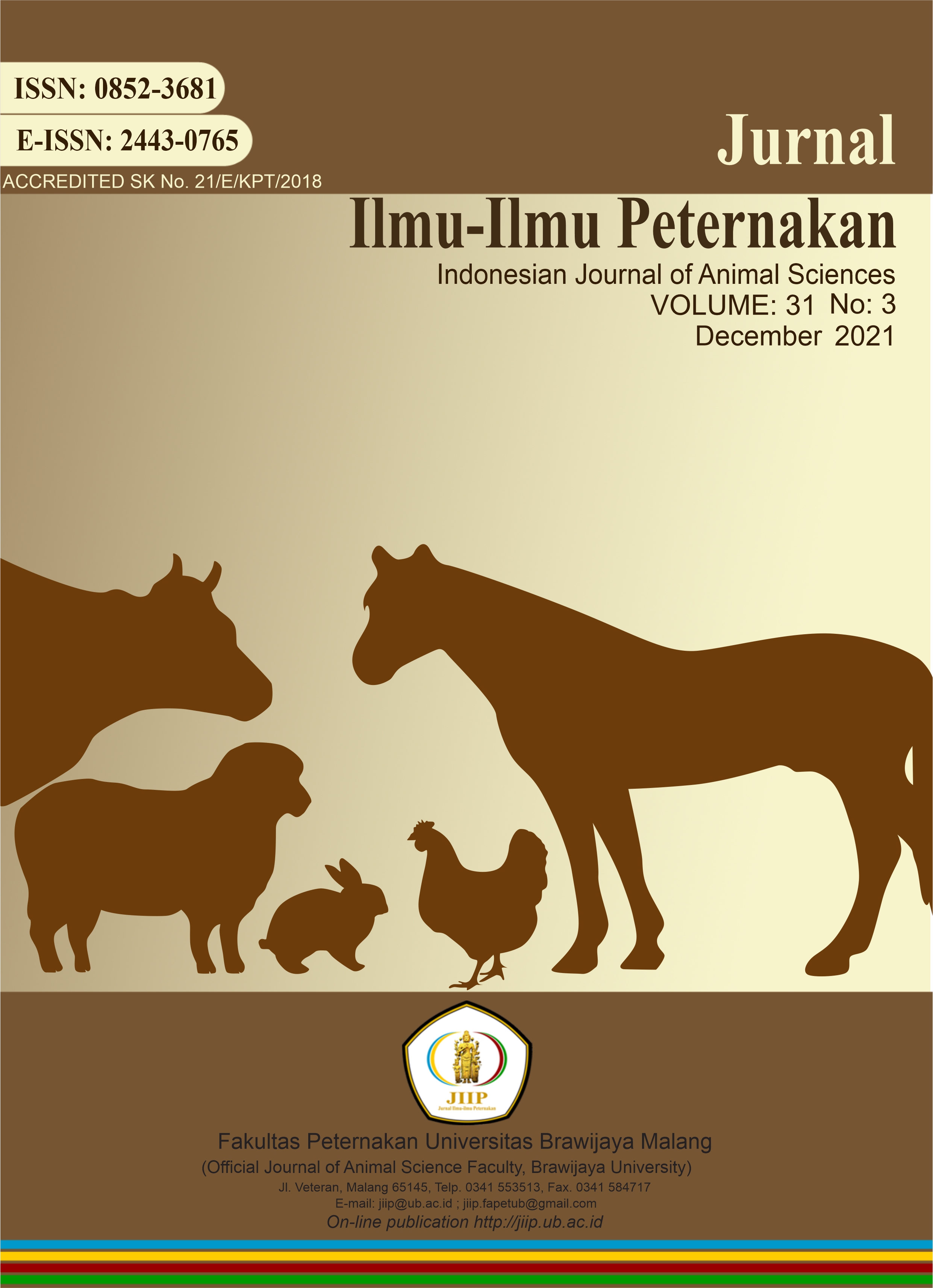Utilization of Jack Bean Seed (Canavalia ensiformis) with Treatments of Protease Enzyme Fed to Broiler in Starter Period
DOI:
https://doi.org/10.21776/ub.jiip.2021.031.03.03Keywords:
Metabolizable energy, Performance, Protease enzymeAbstract
The achievement of this study was to evaluate the use of jack bean seed and protease enzymes in different protein levels in the Broiler ration on performance and metabolizable energy. Two hundred and forty broilers were distributed into 3 object factors and 3 replications. The first factor was the difference of the ingredients (soybean meal-based basal ration and jack bean seed-contained rations), the second factor was the level of protein (22% and 19.5%) and the third factor was the enzyme treatment (without enzymes and with the inclusion of the proteases). A total of 2 birds from each treatment were assigned as a sample for metabolizable energy assay. The experimental design used was a factorial completely randomized design (FCRD). The data were analyzed using Analysis of Variance (ANOVA). The results showed that adding jack bean seed into the Broiler starter’s ration significantly (P <0.01) decreased the body weight gain (BWG) but it could be improved with the inclusion of protease enzyme. The metabolizable energy of the ration containing jack bean seed was significantly higher (P<0.01) than in the basal ration. The use of a low protein level ration (19.5%) significantly (P <0.01) showed the decrease in BWG, decrease in true metabolizable energy, and true corrected-nitrogen metabolizable energy but could be improved with the addition of protease enzyme. The use of the protease enzyme could improve the performance of broiler chickens fed with a low protein ration that contained Jack bean seed (Canavalia ensiformis).
References
Canadian Bio System. 2015. Concentrase-P. diakses 31 Juli 2017 dari; https://canadianbio.com/Enzyme-Supplements.
Farrell, D. J. 1978. Rapid determination of metabolizable energy of foods using cockerels. J Poultry Sci. 19: 303-308.
Hilyati, Sri, B. 1991. Kerentanan tripsin inhibitor biji turi terhadap panas . Agritech. 11 (1) : 2-9
Kasno, A. 2016. Prospek Aneka Kacang Potensial: Koro Pedang sebagai Pengganti Kedelai. Balai Penelitian Kacang dan Ubi. Diakses pada 10 Januari 2018. Dari; http://balitkabi.litbang.pertanian.go.id/?p=4 576.
KEMENDAG (Kementerian Perdagangan). 2017. Perkembangan Impor Menurut HS 6 Digit Periode : 2012-2017. Kementerian Perdagangan RI. Jakarta. Diakses 10 Juli 2020 dari; http://www.kemendag.go.id/id/economicprofile/indonesia-export import/importgrowth-hs-6-digits.
Leeson, S, Summers J, D. 2005. Commercial Poultry Nutrition. 3rd Ed. Nottingham:
Nottingham University Press.
Liu, K. 1999. Soybean: Chemistry, technology, and utilization. Aspen Publ., Inc.
Gaithersburg, Maryland
Lukiwati, D, R., Prawiradiputra, B, R. 2014. Peluang koro pedang sebagai pangan, pakan, dan tanaman obat. Semarang: Universitas Diponegoro
Naiola, E , Widhyastuti, N. 2002. Isolasi, seleksi, dan optimasi produksi protease dari beberapa isolat bakteri. Hayati. 6:467-473.
Patrick, H. and P.J. Schaible. 1980. Poultry Feed and Nutrition. Aci Publ., Co., Inc. Westport. Connecticut.
Primawestri, M.,A., Rustanti, N. 2014. Pengaruh pemberian susu koro pedang (Canavalia ensiformis) terhadap kadar kolesterol total dan trigliserida serum tikus Sprague dawley hiperkolesterolemia.
Downloads
Published
How to Cite
Issue
Section
License
Authors who publish with this journal agree to the following terms:- Authors retain copyright and grant the journal right of first publication with the work simultaneously licensed under a Creative Commons Attribution License that allows others to share the work with an acknowledgment of the work's authorship and initial publication in this journal.
- Authors are able to enter into separate, additional contractual arrangements for the non-exclusive distribution of the journal's published version of the work (e.g., post it to an institutional repository or publish it in a book), with an acknowledgment of its initial publication in this journal.
- Authors are permitted and encouraged to post their work online (e.g., in institutional repositories or on their website) prior to and during the submission process, as it can lead to productive exchanges, as well as earlier and greater citation of published work (See The Effect of Open Access).
















